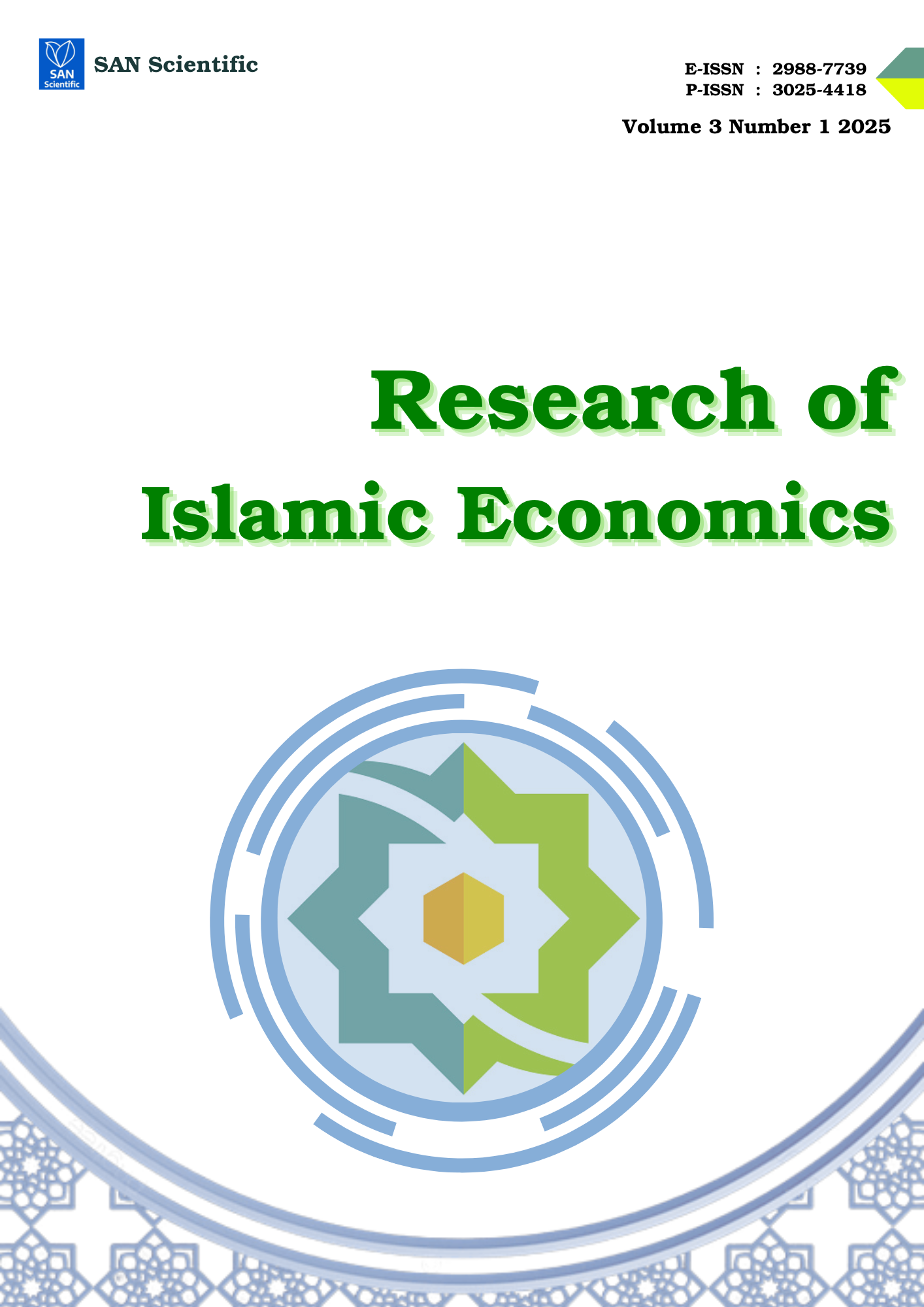The Impact of Basel Standards on Default Risk: A Case of Islamic Banks in Bangladesh
DOI:
https://doi.org/10.58777/rie.v3i1.460Keywords:
Basel III, Capital Adequacy Ratio, Liquidity Coverage Ratio, Net Stable Fund Ratio, Default Risk, Islamic Banks, Random Effect Model, PCSEAbstract
Default risk is a major concern for banks and is shaped by both internal and external factors. Regulatory frameworks like Basel III aim to mitigate such risks. This study investigates the impact of Basel III standards on the default risk of Islamic banks in Bangladesh, focusing on three key indicators: Capital Adequacy Ratio (CAR), Liquidity Coverage Ratio (LCR), and Net Stable Funding Ratio (NSFR). The research covers all Islamic banks in Bangladesh and utilizes secondary data from annual reports. Default risk is assessed using the z-score, where a higher score indicates a lower probability of insolvency. Control variables include credit risk, investment propensity, off-balance sheet exposure, economic growth, and lending rates. A Random Effects Model is employed, with Panel-Corrected Standard Errors (PCSE) applied to address heteroskedasticity, autocorrelation, and cross-sectional dependency. Findings reveal that CAR, LCR, and NSFR significantly reduce default risk, highlighting the effectiveness of Basel III measures in strengthening financial stability. This study uniquely emphasizes Islamic banks and explores the alignment between globally recognized regulatory standards and Sharia-compliant banking. The results offer valuable insights for regulators, policymakers, and bank managers striving to balance regulatory compliance with the principles of Islamic finance.
References
Abdesslem, R. B., Chkir, I., & Dabbou, H. (2022). Is managerial ability a moderator? The effect of credit risk and liquidity risk on the likelihood of bank default. International Review of Financial Analysis (Online)/International Review of Financial Analysis, 80, 102044. https://doi.org/10.1016/j.irfa.2022.102044
Abou-El-Sood, H. (2016). Are regulatory capital adequacy ratios good indicators of bank failure? Evidence from US banks. International Review of Financial Analysis (Online)/International Review of Financial Analysis, 48, 292–302. https://doi.org/10.1016/j.irfa.2015.11.011
Aktan, B., Chan, S., Žiković, S., & Evrim-Mandaci, P. (2013). Off-Balance Sheet Activities' Impact on Commercial Banks' Performance: An Emerging Market Perspective. Ekonomska Istraživanja/Ekonomska IstražIvanja, 26(3), 117–132. https://doi.org/10.1080/1331677x.2013.11517625
Alam, T., Hussain, I., & Saqib, A. (2023). Net Stable Funding and Liquidity Coverage Influence on Islamic Bank Financial Stability: Evidence from Malaysian Islamic Banking. journals.iium.edu.my. https://doi.org/10.31436/ijema.v31i1.1135
Al-Tahat, S., & AbuNqira, N. M. (2016). The impact of Off-Balance Sheet Activities (OBS) on the banking risk and revenue growth for Jordanian commercial banks listed on the Amman Stock Exchange (ASE). https://www.semanticscholar.org/paper/The-Impact-of-Off-Balance-Sheet-Activities-(OBS)-on-AL-Tahat-AbuNqira/f154d6e9565c1259e94cc485e2995a60bb56753e
Amollo, M. O. (2015, November 1). The Relationship between Lending Interest Rates and the Profitability of Commercial Banks in Kenya. http://erepository.uonbi.ac.ke/handle/11295/94516
Aroghene, K. (2023). Effect of Capital Adequacy, Bank Size, and Liquidity on the Stability of FUGAZ Bank in Nigeria. Research Gate. https://www.researchgate.net/publication/368460765_Effect_of_Capital_Adequacy_Bank_Size_and_Liquidity_on_the_Stability_of_FUGAZ_Bank_in_Nigeria?enrichId=rgreq-17ff507147d401953f49a696eb22ec5f-XXX&enrichSource=Y292ZXJQYWdlOzM2ODQ2MDc2NTtBUzoxMTQzMTI4MTExOTc5Mjc0NEAxNjc2MjE5NDI3Nzgx&el=1_x_2&_esc=publicationCoverPdf
Aroghene, N. K. G., & JJE, N. I. (2022). Effect Of Non-Performing Loans (NPLS), Capital Adequacy (CA) And Corporate Governance (CG) On Bank Stability In Nigeria. Finance & Accounting Research Journal, 4(4), 180–192. https://doi.org/10.51594/farj.v4i4.400
Bandyopadhyay, A. (2006). Predicting the Probability of Default of Indian Corporate Bonds: Logistic and Z-Score Model Approaches. ˜the œJournal of Risk Finance, 7(3), 255–272. https://doi.org/10.1108/15265940610664942
Bangladesh Bank. (n.d.). https://www.bb.org.bd/mediaroom/circulars/dos/jan012015dos01e
Basel implementation. (n.d.). https://www.bb.org.bd/mediaroom/baselii/baselII.php
Buchdadi, A. D., Nguyen, X. T., Putra, F. R., & Dalimunthe, S. (2020). The effect of credit risk and capital adequacy on financial distress in rural banks. Accounting, 967–974. https://doi.org/10.5267/j.ac.2020.7.023
Du, B. (2017). How useful is Basel III’s liquidity coverage ratio? Evidence from US bank holding companies. European Financial Management, 23(5), 902–919. https://doi.org/10.1111/eufm.12116
El-Ansary, O., & Hafez, H. (2015, December 27). Determinants of capital adequacy Ratio: An Empirical study on Egyptian banks. https://papers.ssrn.com/sol3/papers.cfm?abstract_id=2708603
Fiordelisi, F., & Mare, D. S. (2013). Probability of default and efficiency in cooperative banking. Journal of International Financial Markets, Institutions & Money, 26, 30–45. https://doi.org/10.1016/j.intfin.2013.03.003
Ghenimi, A., Chaibi, H., & Omri, M. a. B. (2017). The effects of liquidity risk and credit risk on bank stability: Evidence from the MENA region. Borsa Istanbul Review, 17(4), 238–248. https://doi.org/10.1016/j.bir.2017.05.002
Giordana, G. A., & Schumacher, I. (2017). An empirical study on the impact of Basel III standards on banks’ default risk: The case of Luxembourg. Journal of Risk and Financial Management, 10(2), 8. https://doi.org/10.3390/jrfm10020008
Hasan, M. M. (2023, December 5). Cash crunch lingers at crisis-hit Islamic Banks. The Daily Star. https://www.thedailystar.net/business/news/cash-crunch-lingers-crisis-hit-islamic-banks-3486011
Hossain, M. Z., Khan, M. a. R., & Sadique, M. S. (2017). Basel III and the Perceived Resilience of Banks in BRICS Economies. Applied Economics, 50(19), 2133–2146. https://doi.org/10.1080/00036846.2017.1391999
Imbierowicz, B., & Rauch, C. (2014). The Relationship Between Liquidity Risk and Credit Risk in Banks. Journal of Banking & Finance, 40, 242–256. https://doi.org/10.1016/j.jbankfin.2013.11.030
Jayadev, M. (2013). Basel III Implementation: Issues and Challenges for Indian Banks. IIMB Management Review/IIMB Management Review, 25(2), 115–130. https://doi.org/10.1016/j.iimb.2013.03.010
Kaliyev, K., & Nurmakhanova, M. (2020). Bank risk evaluation using the Z-score measure and its impact on the financial health of Kazakhstan's transitional economy industry. Habaršysy. Èkonomika Seriâsy/Habaršy. Èkonomika Seriâsy, 133(3). https://doi.org/10.26577/be.2020.v133.i3.04
Karim, N. A., Al-Habshi, S. M. S. J., & Abduh, M. (2016). MACROECONOMICS INDICATORS AND BANK STABILITY: A CASE OF BANKING IN INDONESIA. Deleted Journal, 18(4), 431–448. https://doi.org/10.21098/bemp.v18i4.609
Karugu, C., Achoki, G., & Kiriri, P. (2018). Capital Adequacy Ratios as Predictors of Financial Distress in Kenyan Commercial Banks. Journal of Financial Risk Management, 07(03), 278–289. https://doi.org/10.4236/jfrm.2018.73018
Kashian, R. D., & Tao, R. (2014). Off-balance sheet activities and community bank performance. Journal of Economic Studies, 41(6), 789–807. https://doi.org/10.1108/jes-01-2013-0010
Keffala, M. R. (2024). The Impact of Off-Balance Sheet Activities on the Credit Risk of African Banks. Journal of Financial Reporting & Accounting. https://doi.org/10.1108/jfra-07-2023-0358
Obadire, A. M. (2022). Banking regulation effects on African banks’ stability. Journal of Financial Risk Management, 11(04), 707–726. https://doi.org/10.4236/jfrm.2022.114034
Report, T. (2023, December 18). Five Islamic banks warned over liquidity shortage: BB. The Business Standard. https://www.tbsnews.net/economy/banking/bb-warns-five-islamic-banks-over-liquidity-concerns-759478
Saad, T. F. W. A. (2024, January 27). BB pumped Tk 96,241 crore into Islamic banks in FY23. The Business Post. https://businesspostbd.com/economy/bb-pumped-tk-96241-crore-into-islamic-banks-in-fy23
Saba, I., Ashraf, H. M. W. A., & Kouser, R. (2017). Impact of Basel III framework on financial distress: A case study of Pakistan. Journal of Accounting and Finance in Emerging Economies, 3(1), 1–20. https://doi.org/10.26710/jafee.v3i1.198
Sang, N. M. (2021). Capital Adequacy Ratio and a Bank's Financial Stability in Vietnam. Banks and Bank Systems, 16(4), 61–71. https://doi.org/10.21511/bbs.16(4).2021.06
Saputra, A. A., Najmudin, N., & Shaferi, I. (2020, October 8). The effect of credit risk, liquidity risk and capital adequacy on bank stability. Saputra | Proceedings of the International Conference on Sustainable Competitive Advantage. http://jp.feb.unsoed.ac.id/index.php/sca-1/article/view/1905
Sharma, A. K., & Chauhan, R. (2023). Impact of Basel III liquidity and capital regulations on bank lending and financial stability: Evidence from emerging countries. Journal of Corporate Accounting & Finance/the Journal of Corporate Accounting & Finance, 34(4), 28–45. https://doi.org/10.1002/jcaf.22630
Staff Correspondent, & Staff Correspondent. (2023, December 15). Liquidity crisis drives five Shariah-based banks towards halt in transactions. Prothomalo. https://en.prothomalo.com/business/trwwwgghw0
Université de Liège, Liège, Belgique. (2016, September 5). The Impact of Basel 3 Capital Requirements on the Performance of European Banks. MatheO - Master Thesis Online. https://matheo.uliege.be/handle/2268.2/1837
Downloads
Published
How to Cite
Issue
Section
Copyright (c) 2025 Md. Adnan Ahmed, Imran Mahmud

This work is licensed under a CC Attribution-ShareAlike 4.0
 Views: 37
|
Views: 37
|
 Downloaded: 12
Downloaded: 12










